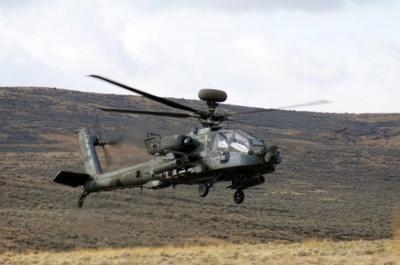Mon, Nov 26, 2012
Battalions Qualified With Individual Aircraft Weapons Systems
The 16th Combat Aviation Brigade began its transition from a force-generating build-up into a training phase, in accordance with Army Force Generation model, with its first aerial gunnery at Yakima (WA) Training Center from Oct. 7 to Nov. 8.

Each subordinate battalion qualified on their individual aircraft weapons system in preparation for the upcoming Collective Crew Training, or CTT, beginning in mid November. The CCT training will be 16th CAB's first combined training, which will incorporate multiple airframes to achieve a single-mission goal. Both the aerial gunnery and CCT are cumulative exercises used to prepare for scheduled training rotations at the National Training Center in southern CA, in 2013.
"We trained to qualify on our primary weapons systems, which will allow us collectively to peruse more advanced training," said Capt. Matthew Ford, 16th CAB assistant operations officer. "This training also will allow us to support other neighboring units and their training requirements, and ultimately to deploy to combat theater and fight to win."
Units qualified on various weapon systems for each airframe, including the OH-58D Kiowa, UH-60 Black Hawk and the AH-64D Apache helicopters. The 46th Aviation Support Battalion played a crucial role by providing retrains capabilities, dining facilities, medical support and forward arming and refueling point personnel. "The biggest lessons we've learned (are) how to integrate the support efforts of multiple [military occupational specialties] so that we can 'plug and play' into a variety of support scenarios," said Lt. Col. Mark Sisco, the 46th ASB commander. "The exercises have given us a higher degree of support flexibility."
"We had a lot of young Soldiers," said Lt. Col. Bryan Hoff, commander of the 2nd Battalion (Assault), 158th Aviation Regiment. "It was their first time in the field and one of our greatest challenges was ensuring they were all well trained and didn't have any accidents, especially when asking them to drive vehicles in excess of 20,000 pounds on uncommon treacherous roads. We took it slow and safe."
The gunnery allowed helicopter gunners to prove they have basic skills and are able to properly identify and engage targets before moving into a CCT and working in a multifunction task force. Soldiers worked together to properly engage targets while hovering, landing and enroute, as well as at various levels of Effective Translation Lift. The ETL is the transitional state present as a helicopter moves from a hover to forward flight. During the CCT, air crews were placed in realistic combat scenarios and all weapons systems were used. Working in multifunction task forces generates the ability to use the different capabilities each airframe brings. By using the various types of helicopters together, unit commanders maximize the strengths of each aircraft, which can support each other with unique, airframe-specific capabilities.
Aerial gunnery is the starting point for several training phases and exercises the 16th CAB will conduct as the unit prepares itself to become fully-mission-capable and ready for worldwide deployment.
(U.S. Army photo)
More News
Aero Linx: Florida Antique Biplane Association "Biplanes.....outrageous fun since 1903." That quote really defines what the Florida Antique Biplane Association (FABA) is all about.>[...]
Beyond Visual Line Of Sight (BVLOS) The operation of a UAS beyond the visual capability of the flight crew members (i.e., remote pilot in command [RPIC], the person manipulating th>[...]
Also: ForeFlight Upgrades, Cicare USA, Vittorazi Engines, EarthX We have a number of late-breaking news highlights from the 2024 Innovation Preview... which was PACKED with real ne>[...]
“For Montaer Aircraft it is a very prudent move to incorporate such reliable institution as Ocala Aviation, with the background of decades in training experience and aviation>[...]
Maximum Authorized Altitude A published altitude representing the maximum usable altitude or flight level for an airspace structure or route segment. It is the highest altitude on >[...]
 ANN's Daily Aero-Linx (04.13.24)
ANN's Daily Aero-Linx (04.13.24) ANN's Daily Aero-Term (04.13.24): Beyond Visual Line Of Sight (BVLOS)
ANN's Daily Aero-Term (04.13.24): Beyond Visual Line Of Sight (BVLOS) Airborne 04.09.24: SnF24!, Piper-DeltaHawk!, Fisher Update, Junkers
Airborne 04.09.24: SnF24!, Piper-DeltaHawk!, Fisher Update, Junkers Aero-News: Quote of the Day (04.14.24)
Aero-News: Quote of the Day (04.14.24) ANN's Daily Aero-Term (04.14.24): Maximum Authorized Altitude
ANN's Daily Aero-Term (04.14.24): Maximum Authorized Altitude



